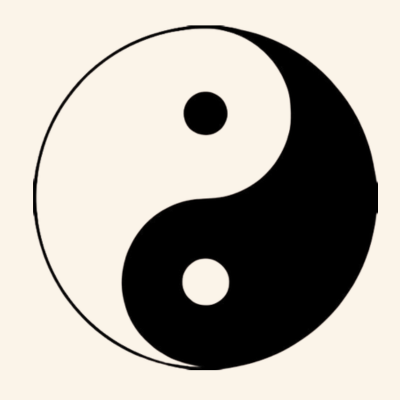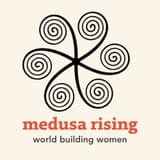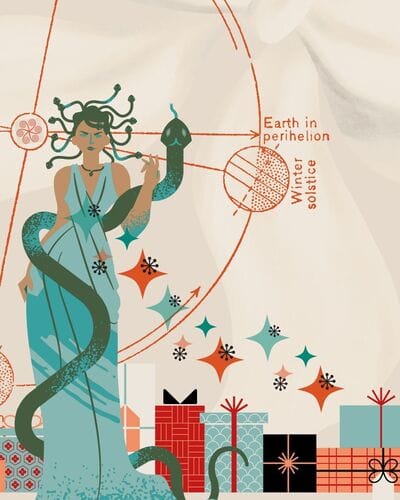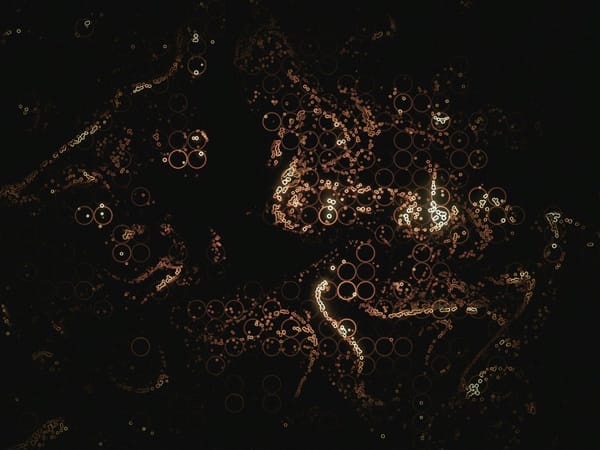Asymmetrical Re-worlding, Part 1: The Pilgrim’s Path Beyond the Mountains of Dualism | by Therese Doherty
Reader-Friendly, Elegant Refutation of 'Postfeminism'

Subscribe between now and Halloween, and get six months of a $12 rate for $8, includes private event invites, first event just after Halloween, two more in winter.
(. ❛ ᴗ ❛.) Or, just leave us a tip. (. ❛ ᴗ ❛.)
We do love to pay these writers, reporters, artists.

Instead of closing in on rigidly formed conclusions, we need to remain open to possibility and all that we do not know.
There is an expansiveness of thought that I love to pursue because it puts me in touch with what is, and what may be, and it gently insists that what I long for is right, while remaining wide and uncertain. Though, understandably, uncertainty can be frightening.
As ecophilosopher David Abram says, ‘We cannot abide our vulnerability, our utter dependence on a world that can eat us … modern humanity is crippled by a fear of its own animality, and of the animate earth that sustains us.’[1] All of us are dependent upon the natural world, and upon women. Yet in their arrogant denial of this dependence, and ‘out of a desire to control nature, men dominate women’[2]—and some women evidently think that is the way things should be.
As someone who has been anti-civilisation[3] for a good while now (perhaps even much of my life), I am frustrated when I hear commentators talking about how we must avert ‘the collapse of western civilisation’ or ‘the disintegration of society’, because as traumatic as it will be, it is a necessary step in the right direction. Cultural and ecological collapse are occurring now, and many people have already lived, or are currently living, through the end of their world. The rise of the Right, authoritarian governments and fascism is also of concern, as they will both accelerate and worsen the effects of these twin collapses. We’ve created hell on Earth.
If we can sow the right values and cultural seeds now, perhaps we can avoid the worst of what is to come, though I don’t believe that our survival as a species is (fully) in our control, because from Evolution’s point of view humans have never been the point. All is process. We need to ride the wave of what is coming, and see what far evolutionary shore we’re eventually cast up on. This will likely occur over many generations, and I’m impatient about this, but I guess like everyone else I’ll just have to wait and see what happens. In the meantime, we do whatever we can to create change. (It sounds pessimistic, I know, but to me there’s a wild uncertainty in all of this which I find reassuring. What will be will be, Gaia willing.)
But it stands to reason that in this climate of change and collapse many people are now clinging to notions of ‘tradition’ and myths of the way things supposedly were, or are supposed to be, to assuage their fears about an uncertain future.
In this series, which will be shared over the next five weeks, I am going to take you on a journey that refutes the backward, nonsensical arguments of so-called ‘postfeminists’, who are trying to bring back biologically essentialist gender roles.[4] In doing so I will examine the trap of metaphysical dualism and how it relates to gender; explore the flowing dance of difference and relationship; argue for the necessity of an end to male domination, and the re-emergence of matriarchy as an egalitarian social system based on care; and start to ponder improved stories about who we are as humans that can overcome our gendered indoctrination and disembodiment. Finally, I’ll end with some seeds to sow to help grow a new conception of human culture—a re-worlding—based on a metaphysics of asymmetry (inspired by Iain McGilchrist’s groundbreaking philosophical work). This will utilise the inyo symbol (the Japanese version of the yin yang), in which The Feminine—as The Human—contains within it both The Feminine and The Masculine. At long last, everyone will be enfolded back into the arms of the Goddess, who is Evolution.
An Account of Postfeminism & a RadMatFem Rebuttal
I read this piece about something called ‘postfeminism’[5] in 2024, and while superficially I agreed with much of it, mistakenly assuming (in part because it quotes Luce Irigaray and Hélène Cixous), that it was some kind of revival of radical feminist principles (my bad!), there were some niggling issues. What, for instance, is the ‘masculine core’ that some women apparently have? Is this a nod to transgenderism, or just plain old sexism? The glib dismissal of the work of our feminist foremothers, and the erroneous assertion that feminism ‘was based on the notion of equality-through-sameness’, also set off alarm bells. There was something rotten lurking under the surface here that I wasn’t yet sure of.
As the months went on and I saw yet more perplexing content I began to think more deeply about what it all meant. ‘Feminists’, apparently, ‘don’t want to slay the patriarchy, they want access to it’. While it is the norm in the patriarchal gender system for women and girls to be conditioned to believe that we are less than men, some postfeminists are engaging in a gaslighting reversal and claiming that it is feminism itself that is responsible for instilling that belief into us, and turning us into victims. Our desire for ‘liberation’ is ill-conceived because it is supposedly founded upon a denial of our femaleness and a wish to be like men. This is one of the core arguments built upon the error of equality-as-sameness that comes up time and time again: feminists want the power that men have—we want to pursue work and success like men, to intellectualise and engage in mental abstraction like men, to fuck around like men—we have abandoned our embodied womanhood and become ‘ontologically male’, and it is damaging our health.
There is certainly some truth in this, but feminists have been all too aware of the pitfalls of participating in the androcentric system. ‘While we value the fact that in this economic system we can support ourselves independently of men’, writes Carolyn Dougherty,
we also recognize that capitalism embeds hierarchy and competition into every aspect of our lives … Our level of comfort with this structure often depends on how successful we are within it, and achieving ‘equality’ with men in this individualized, competitive, alienated, misogynist and destructive economy is ultimately neither healthy nor desirable.[6]
I don’t think women are ‘trying to be male’. We’re trying to survive and be fully human in a world created by and for men. Does that require self-betrayal? Yes, often, and many women grapple with that conundrum. But that’s the nature of patriarchy, which harms everyone. If it were up to feminists we would have dismantled the capitalist system long ago and replaced it with something more humane and sustainable, yet this is the situation we find ourselves in. We have to work with what is, even if that means making some inescapable concessions for the time being.
Though the reversals continue when we’re told that
The male domain — of thought and action — was upheld to the level of the gods, while the female domain — of the body and being, of birth, the ability to bring up the waters of life from below — was unconsciously held as less than. Under the new freedoms of feminism, the symbol of the phallus, the spear, the line of progress still reigned while the yoni, the womb gestating in quiet darkness was held with silent contempt.
Yet this is not only untrue—many feminists have explored the realities of female embodiment and being, sexuality, the wonders of pregnancy, birth and motherhood, and the resurrection of a feminine symbolic (not to mention everything about the ‘male domain’ and the phallic symbolic that is dysfunctional and damaging)—it also reveals the heart of the problem as a fundamental misunderstanding about what feminism really is (and your ‘liberal feminist gender studies class’ will not teach you that). Mary Daly pointed out that the male-defined labels ‘thought’ and ‘action’ are decoys ‘which distract from the reality both of deep knowing and of external action. There is no authentic separation possible.’[7] Everything is embodied and whole.
It’s not that feminism is a perfect movement that has never taken a wrong turn, but what is being described by the postfeminists sounds more like liberal/capitalist/‘sex-positive’ fauxminism than anything that I would identify as feminism at all. (In fact, the quote above sounds like it could be a critique of civilisation and the myth of progress, so that specific line of thinking is misplaced and could have been used to look more deeply into the predicament we find ourselves in as humans, not only as women.) While liberal feminism has a reformist position, wanting to tweak the system in order to enable women to participate more fully in society (which admittedly does produce some benefits), the radical materialist feminist position is (r)evolutionary, aiming to dismantle the system and recreate it on totally different lines.
My position is that liberal feminism—which takes the current system as a given and does not critique the conditions under which we live, but rather endorses the sex industry and harmful forms of sexual behaviour—is not feminism at all. While it may display a veneer of concern for women’s rights via the fight to address the wage gap and workplace harassment, among other issues, and champions the flimsy ideas of ‘empowerment’ and ‘sex positivity’, it manifests more as a patriarchal takeover of feminism, which furthers the aim to divide and conquer women. An essentially male-endorsed movement, liberal feminism has a particularly loud voice, and it drowns out the real, radical, revolutionary feminism that threatens the malestream world, keeping women from hearing the voices they desperately need to hear. I’ve noticed that many women today either find it difficult to call themselves feminists, because of how misunderstood the word is, or are turning away from the concept altogether, so it would seem that the patriarchal-postfeminist strategy is succeeding. What better way to turn women against their own kind than to tell them that the movement that is meant to work for their liberation is actually harmful, and rebranding patriarchy as the key to their liberation!
There are certainly some valid arguments presented by postfeminists about how the malestream world does not suit the rhythms of women’s lives, but what especially irks me is the conspicuous lack of criticism of the patriarchal world itself. Women should not behave like men, yet an acknowledgement of the obvious fact that men also should not behave like men is absent. ‘[W]omen cannot submit to the same rhythms as men’, said Irigaray, but with the crucial additional assertion that ‘men’s rhythms should not be seen as the norm’.[8] Indeed, Riane Eisler says that ‘recognizing the value and integrity of women’s natural cycles goes along with a much-needed shift in attitudes toward nature and the human body—a shift through which the dominator obsession with male superiority and control over both women and nature could finally be left behind’.[9] This shift could be monumental. Yet I get the impression that to the postfeminist mind the way men have organised the system, and the way they behave, is entirely natural, and we should therefore leave them to it—we need only use our feminine wiles to ‘activate’ the allegedly ‘inborn’ masculine ‘instinct to love and protect the feminine’, and, presumably, all will be as it should be. The ‘phallic’ system/symbolic (which does harm to the Earth, and to men too) is only really problematic when applied to women. Thus it is women who must change, who must withdraw from the public realm of visibility and achievement and retreat back into the private, domestic realm, which is portrayed as being where our natural power lies. But this public/private, masculine/feminine split fragments experience, as I will discuss below.
Postfeminists also hype up personal responsibility. If we refuse to be victims—voila!—we are not. Yet being the walking wounded of patriarchal civilisation, which is a truth we should all admit to, as well as being strong and full of potential within its maddening bounds, are not mutually exclusive. We’re both/and. While taking responsibility for ourselves is important, and very much a part of radical feminist practice (it’s actually a deep element of consciousness raising), we need to remember that inner, individual ‘solutions’ are only one part of the picture. The personal is political, and the political is personal. There is also an external, material world out there that Man has created, and though its cultural layers are comparatively recent and quite shallow on the long human scale, they do exert a lot of force. Feminists have been trying to dig through those layers to get back to the matriarchal source for a long time, and it’s not their fault that their work has been stymied at every opportunity. We need to be especially careful not to fall into the trap of perpetuating that popular patriarchal pastime of blaming everything on feminism.
I often think of something that Susan Griffin wrote: ‘A rebellion ultimately imitates that which it rebels against, until the rebel comes to understand himself.’[10] She was talking about the mentality of ‘the pornographic mind’, but I feel that phrase applies to many other things. When we are repulsed by an idea, an ideology, we can react and find ourselves in an opposing stance that has its own deep flaws. This characterises the backlash against feminism that has spawned liberal feminism and transgenderism,[11] amongst other inhumanities, and it now also characterises the ‘reactionary’ rejection of feminism in favour of women’s ‘liberation’ via marriage, the nuclear family, and regressive notions of feminine and masculine essences. While postfeminists will argue that it is not about any kind of harmful domination/submission dynamic between men and women, and that we’re just not understanding the ‘nuance’, that is not borne out by the blunt language that they use: ‘To reject hierarchy in relationships is to reject the design of nature.’ Thus they are merely leading us full circle back to where we started instead of giving us the (self-)understanding of our situation that enables us to break free from the patriarchal double bind altogether.
My long pondering has led to this pilgrim’s path of response to all of that postfeminist absurdity. I was, I’m sad to say, a latecomer to reading THE RADICAL NOTION, so it wasn’t until I read Jane Clare Jones’s review of Mary Harrington’s Feminism Against Progress that everything finally began to make sense. My suspicion that some women were understandably rejecting liberal fauxminism, but mistakenly conflating it with feminism as a whole, and then creating an antifeminist distortion in its place was, pleasingly, confirmed. According to Jones, Harrington fails to understand that
liberal ideals of disembodied autonomy are key to the male-default patriarchal subject, and that the liberal feminist embrace of ‘gender neutrality’ derives from efforts to liberate women within the patriarchal paradigm, on the basis of patriarchal notions of what it means to be human. Instead of understanding that the disembodied ‘gender neutral’ (but actually male) default is a product of patriarchy, Harrington equates liberal feminism’s embrace of this default with feminism as such, erasing a long and varied tradition of radical and materialist feminist thinking that focuses precisely on critiquing liberal capitalist notions of autonomy and equality-as-sameness as based on patriarchal constructions of the human. This then allows Harrington to indict feminism, rather than patriarchy, for the cultural malaise created by capitalist atomization, and paves the way for her avowedly ‘reactionary’ retreat to the patriarchal family as an antidote to a public sphere governed by allegedly ‘feminist’ ideals of capitalist liberal autonomy.[12]
Jones’s term ‘reactionary post-liberal feminists’[13] perfectly describes what is going on with Harrington, Louise Perry, and their ilk and the fact that they are still slickly marketing themselves as some kind of ‘feminist’ makes their message especially deceptive.
There are many strands to this postfeminist propaganda, but one of the things that stands out is an old idea dressed up in newer, yet no less ugly, clothing: that of feminine/masculine polarity. In one article I came across the very first sentence had me wanting to bang my head against a wall: ‘The mind/body duality is as fundamental to universal nature as masculine/feminine duality.’
Shifting into Difference
I mean, really? Does any credible thinker believe in mind/body dualism these days? It’s a conceptual error in Western thought which we can trace back to certain Greek philosophers (Plato, I’m looking at you!), though it reached its most insidious form during the Enlightenment, thanks to Descartes et al. Indeed, a whole system of dualisms has characterised Western philosophy, which feeds into the polarity of gender (aka sex role stereotypes = sexism), and such divisions operate at a deep subconscious level. (Tellingly, ‘liberal feminism, which accepts the dominant culture, has not had much use for the concept [of dualism]’,[14] which explains why the postfeminists have no critique of it.)
Because we are a sexually dimorphic species, ‘human societies have responded to the bodily differences between the two sexes in dualistic ways that shape the life experience of every individual’, Charlene Spretnak tells us. ‘Born into a particular culture, most people regard that orientation as “the natural way,” or at least, if they become aware of other cultural choices, “the proper way.”’[15]
There’s nothing inherently bad about recognising these differences—as we’ve seen with the rise of sex-denialism in recent years, it’s actually necessary for the safety and well-being of women and girls—but a dualism is not just a difference, it’s a difference plus hierarchy (also thought of as a ‘binary’). Ecofeminist philosopher Val Plumwood elaborates:
In dualism, the more highly valued side (males, humans) is construed as alien to and of a different nature or order of being from the ‘lower’, inferiorised side (women, nature) and each is treated as lacking in qualities which make possible overlap, kinship, or continuity. The nature of each is constructed in polarised ways by the exclusion of qualities shared with the other; the dominant side is taken as primary, the subordinated side is defined in relation to it. Thus woman is constructed as the other, as the exception, the aberration or the subsumed, and man treated as the primary model. The effect of dualism is, in Rosemary Radford Ruether’s words, to ‘naturalise domination’, to make it part of the very natures or identities of both the dominant and subordinated items and thus to appear to be inevitable, ‘natural’.[16]
Extrapolated out from the differences of our bodies are a whole range of ideas that serve to limit and distort us, and these ideas are certainly not ‘natural’. As I said in my review of Catherine Keller’s From a Broken Web, ‘the differences between [women and men] would likely be much less stark in the absence of gendered socialisation, which splits us off from each other and limits our potentials, endangering our future as a species, while causing us all so much misery’. And the more I’ve read on this subject, the more true that statement has become.
There would be no Evolution without sex differences, and difference is what makes relationship possible. It produces diversity, complexity and adaptability, and actualises the possibilities that enable the continual processes of evolutionary change. But when we attach values to those differences that lead to personalities, behaviours and opportunities being curtailed or rigidly prescribed—the false differences that we call gender—our potential as humans is reduced and impeded. Yet in Delusions of Gender Cordelia Fine assures us that ‘Our minds, society and neurosexism create difference. Together, they wire gender. But the wiring is soft, not hard. It is flexible, malleable and changeable. And, if we only believe this, it will continue to unravel.’[17] Absent that gendered wiring, we will finally be free to be ourselves—women and men with all of our diverse personalities, abilities, sexualities, and modes of expression. This is true difference, in all its gorgeous plurality and expansiveness.
It is mind-boggling to me why some women are falling into the gender trap, taking on such regressive biologically essentialist ideas about what women and men are supposed to be, because it reveals not just an astonishing ignorance of well-established feminist theory, but also a distinct lack of imagination. It’s reification and naturalistic fallacies on overdrive. Beyond that, it’s particularly bewildering when they are supposedly opposed to transgenderism as they don’t seem to realise that the very polarity they are upholding is what creates the conditions for transgenderism to arise in the first place: ‘“Any culture that insists on individuals committing themselves to one pole of a duality,” [said anthropologist] Roy Willis, “exposes itself to the risk that some will find the forbidden option too attractive to be forgone.”’[18]
In her beautiful and profound collection of essays, The Eros of Everyday Life, Griffin writes:
The idea of masculinity and femininity, and a complementary heterosexuality, served to symbolize a separation between spirit and matter, mind and body and make this schism seem, even to a small degree, real. By a similar logic the idea of the superiority of the white race was another way European culture had been able to imagine itself as elevated above nature. Both the movement of women away from the traditional feminine role and the shattering of a myth of race endangered the stability of the entire system.[19]
Feminine/masculine polarity is embedded in the system of metaphysical dualism that perhaps originated in the demotion and dividing of the Great Goddess who initially embodied a holistic, gynandrous and flowing worldview. Dualism destroys that worldview, creating and upholding various forms of othering and oppression, and sustaining a fragmentation of the way we see reality and each other: ‘experience itself is divided into separate worlds, not only masculine and feminine, but also public and private, sacred and profane, intellectual and emotional.’[20] This is profoundly alienating and anti-ecological. Plumwood says that ‘the dualisms of male/female, mental/manual (mind/body), civilised/primitive, human/nature correspond directly to and naturalise gender, class, race and nature oppressions respectively’.[21] Dominators and the subjugated. Masters and slaves. The fully human and the Other.
Difference is natural, but these dualisms are not. They are ‘the conceit of the patriarchal mind, built over—and in defiance of—the densely interwoven nature of existence’.[22] aurora linnea writes:
Dualism slanders reality. For the real living world is zealously, promiscuously, anti-dualistic. The boundaries between one body and another, between my body and the dirt, between the soil and the roiling sea of the air are not the hard, straight-edged lines Man draws with such exacting precision, but more misted.[23]
To challenge these dualisms is therefore to destabilise the patriarchal system of domination and fragmentation in favour of something more humane, more whole, more grounded in freedom and the integration of the many diverse facets of all that we are. Difference without hierarchy, and instead, a web of interrelation. To get a bit philosophical: the relationship precedes the relata, and opposites actually coincide. It’s in the betweenness that relationship happens, as we respond to context and circumstance. This destabilisation and wild ‘promiscuity’ is of course a threat to patriarchal society, and to anyone who wants to remain ensconced in neatly defined roles and power positions.
These dualistic ideas pervade the dominant culture so deeply that they often remain unperceived. For those of us who have become aware, trying to overcome them can be a difficult task leading to even more confusion if we set out without a proper map. As Plumwood playfully wrote, ‘the misty, forbidding passes of the Mountains of Dualism have swallowed many an unwary traveller in their mazes and chasms.’ Not only do we have to traverse the ‘Cavern of Reversal’ and make it past the nearby ‘Well of Discourse’ (where many a postmodernist finds themselves ‘gazing in dismay into the fearful and bottomless Abyss of Relativism’), next there is the ‘Swamp of Affirmation’, beyond which many travellers ‘either fall into the Ocean of Continuity on the one side or stray into the waterless and alien Desert of Difference on the other, there to perish.’ Plumwood concludes that ‘The pilgrim’s path to the promised land leads along a narrow way between these two hazards, and involves heeding both difference and continuity’.[24]
What is required to successfully complete the journey beyond the Mountains of Dualism is both/and thinking, the ability to dance between the opposites, to deconstruct and then integrate them. ‘A deconstructed binary is a constant oscillation between poles,’ says Jones, ‘just like the yin yang, which is designed to suggest a circle spinning.’[25] The yin yang (or taijitu) symbol contains a dot of each side’s opposite within them, for Darkness cannot be without her sister Light. As I said above, opposites coincide. They contain each other, while remaining distinct. There is a delicious paradox here.

Therese Doherty lives with chronic illness and occasionally writes and makes art, but mostly just reads a lot. She can be found @offeringsfromthewellspring and you can peruse and purchase her artwork at Offerings From the Wellspring at Redbubble.
David Abram, Becoming Animal: An Earthly Cosmology, Vintage Books: New York, 2010, p. 69 ↩︎
Susan Griffin, Made From This Earth: An Anthology of Writings, Harper & Row: New York, 1982, p. 16 ↩︎
I define civilisation as any culture that develops cities. Thus civilised cultures are inherently unsustainable, while non-civilised cultures generally are. This has nothing to do with the cultural sophistication of the society, or the way people behave (civilised people are sometimes the least “civilised”). ↩︎
This isn’t a new trend, just the latest iteration. Riane Eisler, writing three decades ago, noted that ‘revivals of “essentialist” gender roles through fundamentalism, neoconservatism, sociobiology [now evolutionary psychology], and some neo-Jungian mythopoetic writings [are] attempts to make something that is socially constructed appear as instinctual or biological.’ Sacred Pleasure: Sex, Myth, and the Politics of the Body, HarperOne, 1995, pp. 310 (ebook page number) ↩︎
In this particular instance, it stands for ‘post-patriarchal feminism’ (an oxymoron). ↩︎
Carolyn Dougherty, ‘An Economy that Included Women: The ‘Sociable Economy’ of Georgian England’, THE RADICAL NOTION, Issue Three (Spring 2021), p. 82 – all issues are available to read online or download for free here: https://theradicalnotion.org/ ↩︎
Mary Daly, Gyn/Ecology: The Metaethics of Radical Feminism, Beacon Press: Boston, 1978/1990, p. 54 (ebook page number) – find this book in the Radical Feminist Library ↩︎
Luce Irigaray (translated by Karin Montin), Thinking the Difference: For A Peaceful Revolution, Routledge: New York, 1994, p. 62 ↩︎
Eisler, pp. 356 (ebook page number) ↩︎
Susan Griffin, Pornography and Silence: Culture’s Revenge Against Nature, Harper & Row: New York, 1981, p. 16 ↩︎
I have written about this on my blog, in a piece called Finding the Bedrock. ↩︎
Jane Clare Jones, ‘Feminism Against Capitalism: A Review of Feminism Against Progress’, THE RADICAL NOTION, Issue Nine (Spring/Summer 2023), p. 80 ↩︎
Jane Clare Jones, ‘Feminism is Not Identity Politics: Transactivism, Gender-Critical Populism, and the Culture War’, THE RADICAL NOTION, Issue Eight (Autumn/Winter 2022), p. 83 ↩︎
Val Plumwood, Feminism and the Mastery of Nature, Routledge: London, 1993, p. 32 – find this book in the Radical Feminist Library ↩︎
Charlene Spretnak, States of Grace: The Recovery of Meaning in the Postmodern Age, HarperSanFrancisco: New York, 1991, p. 114 ↩︎
Plumwood, p. 32 ↩︎
Cordelia Fine, Delusions of Gender: The Real Science Behind Sex Differences, Icon Books: London, 2010, p. 162 (pdf page number) – find this book in the Radical Feminist Library ↩︎
Paul Shepard, Thinking Animals: Animals and the Development of Human Intelligence, University of Georgia Press: Athens, Georgia, 1978/1998, p. 158 ↩︎
Susan Griffin, The Eros of Everyday Life: Essays on Ecology, Gender and Society, Doubleday: New York, 1995, p. 20 ↩︎
Griffin, The Eros of Everyday Life, p. 41 ↩︎
Plumwood, p. 43 ↩︎
Jane Clare Jones, ‘The Cyborg vs. the Goddess’, THE RADICAL NOTION, Issue Six (Winter 2022), p. 81 ↩︎
aurora linnea, Man Against Being: Body Horror and the Death of Life, Spinifex Press: Little River, Victoria, 2024, p. 227 – linnea goes on to say in a footnote: ‘The undoing of dualisms I envision here should not be mistaken for the gross bulldozing of difference performed by the queer theory tenet of “fluidity,” with its implicit goal of casting doubt on human sexual dimorphism … Our skin may be porous and permeable, our cells mostly water, but our bodies are not, as it happens, composed of some malleable gloop, forever oozing slimily through a limitless multiplicity of morphologies. Man’s reductive and oversimplifying dualisms do not describe reality, but neither does the wishful thinking that would deprive nature of all its meaningful, material distinctions.’ p. 228 ↩︎
Plumwood, p. 3 ↩︎
Vojin Saša Vukadinović, ‘Explanatory Power: Gender-Critical Feminism and Trans Ideology: An Interview With Jane Clare Jones’, THE RADICAL NOTION, Issue Four (Summer 2021), p. 106 ↩︎
Subscribe between now and Halloween, and get six months of a $12 rate for $8, includes private event invites, first event just after Halloween, two more in winter.
(. ❛ ᴗ ❛.) Or, just leave us a tip. (. ❛ ᴗ ❛.)
We do love to pay these writers, reporters, artists.
Groove with The Gorgon Posse Playlist
Songs for Breaking Up with Male Supremacy
Reach out anytime for any reason: info@medusarising.org.
( ^-^)ノ∠※。.:*:・'°☆ ( ^-^)ノ∠※。.:*:・'°☆ ( ^-^)ノ∠※。.:*:・'°☆




